|
|
|
Sort Order |
|
|
|
Items / Page
|
|
|
|
|
|
|
| Srl | Item |
| 1 |
ID:
173765
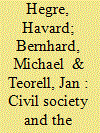

|
|
|
|
|
| Summary/Abstract |
We theorize that three distinct structures of democratic constraint explain why more democratic dyads do not engage in military conflict with each other. We build on earlier theories that focused on electoral and horizontal accountability. We add a new dimension—the social accountability provided by an active civil society. Using several new measures from the Varieties of Democracy (V-Dem) data set, we stringently test these explanations. We find social accountability to be the strongest and most consistent predictor of nonbelligerence in dyads, that horizontal accountability is still important, but that the independent role of electoral accountability has been somewhat overstated. However, we do find that social and electoral accountability work strongly together, to make for an even greater effect. The finding is robust to a range of specifications and in the face of controls for contending theories that challenge the democratic peace (e.g., the capitalist and territorial peace theories).
|
|
|
|
|
|
|
|
|
|
|
|
|
|
|
|
| 2 |
ID:
173764
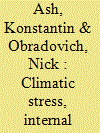

|
|
|
|
|
| Summary/Abstract |
Syria recently suffered a once in 500-year meteorological drought followed by one of the worst conflicts of the twenty-first century. We exploit subnational variation in drought impact to examine associations between climatic stress and Syria’s political unrest. Climatic stress may produce instability through both immediate hardship and, indirectly, internal migration. Consistent with the internal migration hypothesis, we find less severely drought-stricken Syrian regions more likely to experience protest. We employ nighttime lights as a proxy for population density to examine the association between climatic stress and internal displacement. We find climatic stress decreased nighttime light intensity during the drought period. Increases in nighttime lights from 2005 to 2010 are associated with added risk of protest in Sunni Arab areas, suggesting an influx of migrants bolstered local grievances. Our findings support the internal migration hypothesis and suggest extreme climate events may impact civil unrest via geographically and temporally indirect paths.
|
|
|
|
|
|
|
|
|
|
|
|
|
|
|
|
| 3 |
ID:
173768
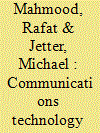

|
|
|
|
|
| Summary/Abstract |
By facilitating the flow of information in society, communications technology (CT; e.g., newspapers, radio, television, the Internet) can help terrorists to (i) spread their message, (ii) recruit followers, and (iii) coordinate among group members. However, CT also facilitates monitoring and arresting terrorists. This article formulates the hypothesis that a society’s level of CT is systematically related to terrorism. We introduce a simple theoretical framework, suggesting that terrorism first becomes more attractive with a rise in CT, but then decreases, following an inverted U shape. Accessing data for 199 countries from 1970 to 2014, we find evidence consistent with these predictions: terrorism peaks at intermediate ranges of CT and corresponding magnitudes are sizable. Our estimations control for a range of potentially confounding factors, as well as country fixed effects and year fixed effects. Results are robust to a battery of alternative specifications and placebo regressions. We find no evidence of a potential reporting bias explaining our findings.
|
|
|
|
|
|
|
|
|
|
|
|
|
|
|
|
| 4 |
ID:
173767
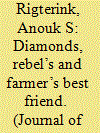

|
|
|
|
|
| Summary/Abstract |
This article investigates the impact of the world price of a “lootable,” labor-intensive natural resource on intensity of violent conflict. Results suggest that a price increase can have opposite effects at different geographical levels of analysis: a decrease in conflict intensity overall in resource-rich countries, but an increase in conflict intensity in resource-rich subnational regions. The article argues that intensity of violence decreases overall due to rising opportunity costs of rebellion but that violence concentrates in resource-rich areas as returns to looting rise. The article introduces a new measure of diamond propensity based on geological characteristics, which is arguably exogenous to conflict and can capture small-scale labor-intensive production better than existing measures. The stated effects are found for secondary diamonds, which are lootable and related to opportunity costs of fighting, but not for primary diamonds, which are neither.
|
|
|
|
|
|
|
|
|
|
|
|
|
|
|
|
| 5 |
ID:
173769
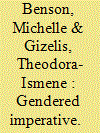

|
|
|
|
|
| Summary/Abstract |
There is increasing awareness that sexual violence is distinct from other aspects of civilian victimization in civil wars. Few studies have examined the independent impact of such violence on responses to civil wars as compared to “traditional” forms of violence. This article explores whether reports of high levels of rape and sexual violence increase the probability of United Nations (UN) attention to conflicts and calls to action. In so doing, we combine original data on UN Security Council (UNSC) resolutions with data on sexual violence in armed conflict and estimate the impact of sexual violence on UN attention to all civil wars from 1990 to 2009. We show that the effects of sexual violence on the number and level of UNSC resolutions are significant even when controlling for other important determinants of UN action. These findings have important implications for understanding how the UN has expanded its view on protecting civilians.
|
|
|
|
|
|
|
|
|
|
|
|
|
|
|
|
| 6 |
ID:
173766
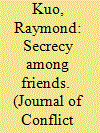

|
|
|
|
|
| Summary/Abstract |
Scholars think that friendly nations adopt secrecy to avoid domestic costs and facilitate cooperation. But this article uncovers a historical puzzle. Between 1870 and 1916, over 80 percent of alliance ties were partially or completely covert. Otherwise, hidden pacts are rare. Why was secrecy prevalent in this particular period and not others? This article presents a theory of “portfolio consistency.” Public agreements undermine the rank of hidden alliances. A partner willing to openly commit to another country but not to you signals the increased importance of this other relationship. States pressure their covert partners to avoid subsequent public pacts. This creates a network effect: the more secret partners a state has, the greater the incentives to maintain secrecy in later military agreements. Covert alliances have a cumulative effect. In seeking the flexibility of hidden partnerships, states can lock themselves into a rigid adherence to secrecy.
|
|
|
|
|
|
|
|
|
|
|
|
|
|
|
|
|
|
|
|
|